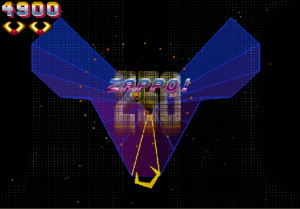Tempest 2000: Stuck
Even taking full advantage of my infinite continues, I can only manage to get to a level somewhere into the early-to-mid 40’s. At that point, I simply stop making progress.
To understand this fully, you have to understand a bit more about the game than I’ve yet described. First of all, dying even once means you have to start the level over from scratch. Things you killed before you died are resurrected along with you, and any powerups other than warp tokens are lost. (On the plus side, dying recharges your superzapper, the kill-everything weapon that can be used once per life per level.) Thus, the only way to make lasting progress within a game is to actually finish a level, and, although you’re given three lives (to start with), you have to do it within the span of a single life. To make progress within a series of games, however, you have to finish two levels (not necessarily with the same life). This is because of an odd limitation on the levels you can continue from — that is, you can only continue from the odd levels.
Now, there’s a substantial luck factor in this game, and not just because the granularity of crucial events is beyond the ability of humans to control, predict, or perceive. Powerups are very important, and (apart from the first one on every level, which always gives you a “Particle Laser” 1OK, actually it’s a little more complicated than that. If you manage to grab a powerup while sliding down the web on completing a level (the “Avoid Spikes” phase), your first powerup in the next level will be an AI Droid.) completely random. And some of them are much more useful than others. If you manage to get an AI Droid powerup, it’ll wander around shooting things for you so you can concentrate on defense, and on picking up more powerups. Even better, the rare Outta Here powerup simply ends the level immediately.
So, even when you’re out of your depth, there’s some chance that you’ll have an easy time of it, but it’s a crapshoot. In fact, since the entire state of the level resets when you die, each life can be regarded as an independent trial with the same probability of success. If it weren’t for the odd limitation, the number of lives you have would be unimportant. No death would have any impact on the next life’s ability to result in permanent progress. If you have a 25% chance of passing a level, it’ll take an expected 4 tries, and so will the next level, more or less (the difference in difficulty between successive levels being insignificant), for a total of 8 tries — more than you get in a single continue. But since you need to pass two levels at a time in order to get anywhere, it makes a big difference whether you have 8 lives in reserve or only 3.
Now, in the early part of the game, at the easier stages, one tends to accumulate lives. This gives the player a certain momentum. You eventually reach a point where you’re losing lives faster than you’re gaining them, but your reserves catapult you onward. Consequently, when the game finally ends, you’re not at the limit of your ability, but well past it.
| ↑1 | OK, actually it’s a little more complicated than that. If you manage to grab a powerup while sliding down the web on completing a level (the “Avoid Spikes” phase), your first powerup in the next level will be an AI Droid. |
|---|
 Comments(0)
Comments(0)